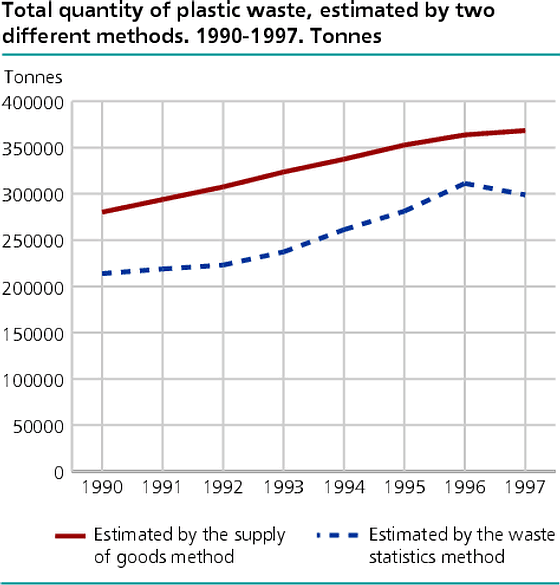Content
Published:
Plastic waste increased by 30 per cent
The quantity of plastic waste increased by 30 per cent from 1990 to 1997. The amount of plastic waste that was generated in Norway in 1997, was 366 000 tonnes.
Two different methods are applied to estimate the total quantities of plastic waste arising each year: The supply of goods method and the waste statistics method. The two methods focus on slightly different phases in the plastic life cycle. Thus, they are used to estimate generated and disposed quantities, respectively. In theory, the divergence between these quantities expresses the amount of waste that each year is disposed of outside the official waste disposal system. In practice, some of the divergence must be attributed to uncertainties in the estimates.
Increase of 30 per cent
According to the supply of goods method, 366 000 tonnes of plastic waste was generated in Norway in 1997. The waste statistics method indicates that 296 000 tonnes were disposed of the same year, which suggests that 19 per cent of the generated waste ended up outside the official waste disposal system in 1997. Since 1990 the generated quantities have increased by 30 per cent, while the gap between generated and disposed quantities has decreased by 5 per cent. This could indicate an improvement in the waste statistics during the last years.
51 per cent from households
In 1997, 83 000 tonnes, or 23 per cent, of the generated quantities came from packaging products. This figure is probably slightly underestimated due to a possible product classification error. 51 per cent of the generated quantities came from the households in 1997. This share has been relatively stable since 1990, but the quantity has increased in correspondence with the increase in the total quantities. In 1997, only 2 per cent of the generated plastic waste was recycled, while 61 per cent was deposited. The figures on treatment should be read with extra caution due to few data sources with variable reliability.
Tables:
The statistics is published with Waste accounts.
Contact
-
Statistics Norway's Information Centre
E-mail: informasjon@ssb.no
tel.: (+47) 21 09 46 42

